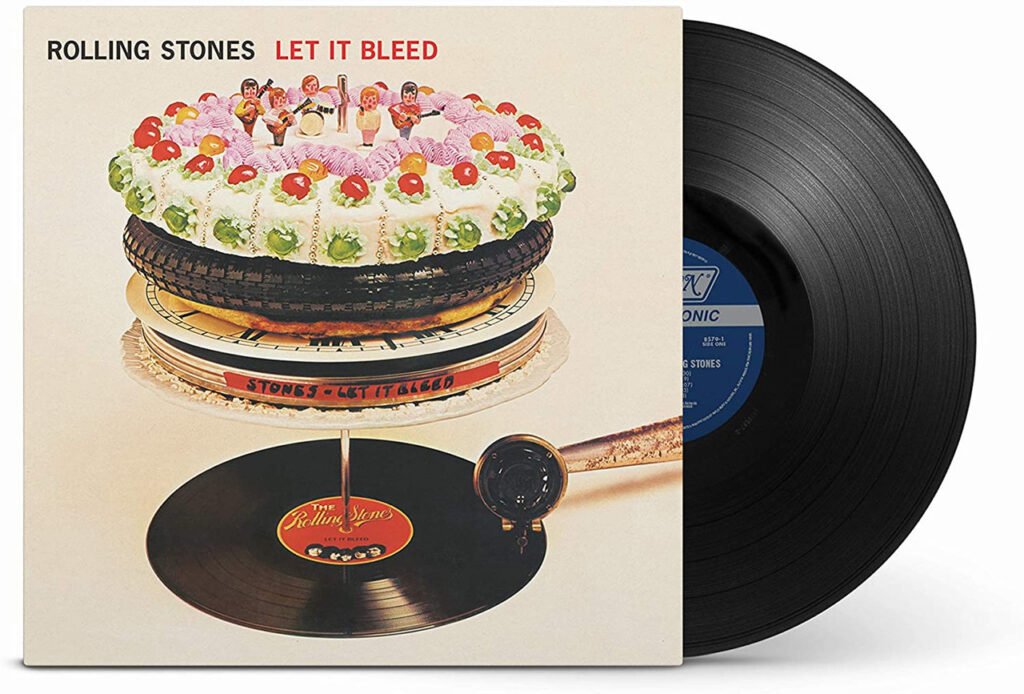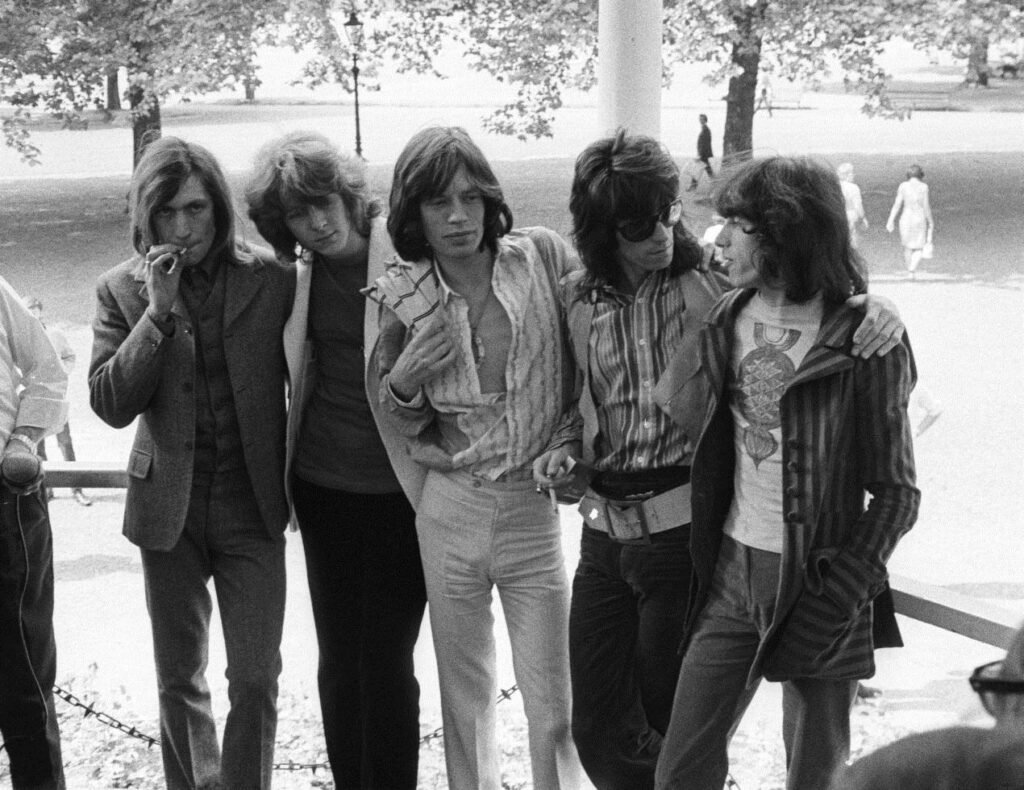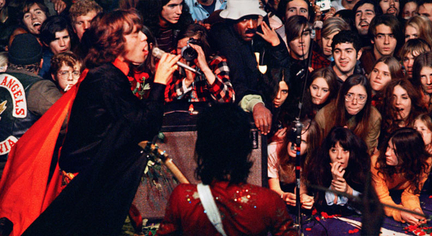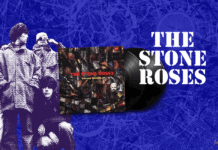Let It Bleed (1969): The Rolling Stones’ Beautifully Deranged Break-Up Letter to the 1960s
Imagine the swinging ‘60s as a car careening off a cliff in slow motion, with flowers flying out the windows and someone in the back screaming about free love while setting their own hair on fire. That’s Let It Bleed. It’s not so much an album as it is a sonic car crash on the psychedelic motorway, blood on the tarmac, sitars in the bushes and Mick Jagger rifling through your wallet while pretending to sing about revolution.
Released in 1969, Let It Bleed is the moment The Rolling Stones stopped flirting with darkness and dry-humped it to completion. It’s apocalyptic, lecherous and about as comforting as a wet mattress in a crack den. Where The Beatles were busy farting around with harpsichords and animal noises on Abbey Road, the Stones decided to soundtrack the end of the world with slide guitar and songs about murder. Because of course they did.
Table of Contents

Welcome to the Last Supper of the ’60s
Released in December 1969, Let It Bleed wasn’t so much an album as it was a weather report for the decade’s death rattle. The Beatles were disbanding, flower power had wilted into paranoia and the Rolling Stones decided to throw a funeral disguised as a blues-infused orgy. It arrived a mere four months after Woodstock, but with the chilly sneer of Altamont looming around the corner. If Beggars Banquet was the sound of a band flirting with danger, Let It Bleed was them making it breakfast and asking it to move in.
Here, the Stones aren’t pretending to be groovy anymore. They’re jaded, snarling and fully committed to sounding like the last band on Earth. And somehow, it’s brilliant.
A Band Held Together by Drugs and Spite
At this point in their career, the Stones were functioning less like a band and more like a dysfunctional family held together by passive aggression and pharmaceutical-grade narcotics. Brian Jones had mentally checked out years earlier and was physically removed not long after – fired, drowned and replaced all in the time it takes to microwave a burrito. Mick Taylor technically joined around now but was barely involved in Let It Bleed, which leaves Keith Richards to do most of the heavy lifting while presumably chain-smoking through every orifice.
The result? A record that sounds like it was recorded during a seance on the Titanic. It’s astonishingly good, but also so grim you feel like you need a tetanus shot after listening.

Grit, Grime and Gospel: A Track-by-Track Breakdown
1. Gimme Shelter
The musical equivalent of a panic attack in slow motion. That guitar riff? It doesn’t so much start the song as it kicks the door in and sets your curtains on fire. Jagger sounds like he’s whispering in a foxhole, while Merry Clayton belts “rape, murder, it’s just a shot away” like she’s trying to exorcise the entire decade. If there’s a better sonic representation of a societal nervous breakdown, I haven’t heard it – and if I had, I probably blocked it out.
2. Love in Vain
A Robert Johnson cover that sounds like something you’d hear playing from a rusty radio in a ghost town where even the tumbleweeds have depression. It’s tender, yes, but in the same way a hangover is “meditative.” Richards’ slide guitar is lovely though, like a drunk trying to apologise.
3. Country Honk
Right. So here’s Honky Tonk Women, one of the best songs they’ve ever done, re-recorded as a fiddly country piss-take that makes you want to punch your own ears. It’s a joke. At least I hope it’s a joke. If it’s not, someone owes the concept of music an apology.
4. Live With Me
Welcome to the sleaziest song this side of a nightclub toilet. It’s got a saxophone solo so filthy you feel like you should be wearing gloves just to hear it. The lyrics sound like Jagger’s reading out the rap sheet of every character from The Wolf of Wall Street and somehow it’s still a banger.
5. Let It Bleed
Yes, the title track. Cheerfully nihilistic, like if The Muppets covered Leonard Cohen. Jagger practically giggles through lyrics about drug dependency and emotional codependency like it’s all a bit of a lark. “We all need someone we can bleed on” – yes, Mick, ideally a trained medical professional, not you in snakeskin trousers.
6. Midnight Rambler
Seven minutes of bluesy serial killer roleplay. Allegedly inspired by the Boston Strangler, which is fun. It speeds up, slows down and slithers around like it’s trying to get away with something. Jagger does this weird thing where he whispers and moans like a werewolf about to climax. It’s deeply unsettling. And yet somehow, weirdly brilliant. You’ll hate yourself for enjoying it.
7. You Got the Silver
Keith Richards sings and miraculously, it doesn’t sound like a wardrobe falling down a flight of stairs. In fact, it’s rather lovely in a gravel-voiced, whisky-stained sort of way. The kind of song that plays at 3 a.m. in a bar where the only lighting is a flickering fridge and your regrets.
8. Monkey Man
This one sounds like they recorded it on a dare in someone’s basement while high on experimental horse tranquilizers. There’s piano, menace, nonsense lyrics and Jagger howling that he’s a “monkey man” as if he’s just discovered it himself. It’s brilliant chaos-deranged, decadent and somehow funkier than it has any right to be.
9. You Can’t Always Get What You Want
The big philosophical closer, backed by a bloody boys’ choir because why not? It’s basically the Stones trolling optimism. “You can’t always get what you want” is a lovely sentiment if you’re eight years old and your mum won’t let you have a biscuit. Here, it lands like a smirking eulogy for the entire decade. The French horn intro? Unnecessarily posh. The gospel climax? Completely ridiculous. And yet… it works. Of course it does.
Blood on the Tape: Production & Recording Mayhem
You’d be forgiven for thinking Let It Bleed was recorded in a war zone with occasional breaks for guitar overdubs. In reality, the chaos was slightly more organised and happened at Olympic Studios in London and Sunset Sound in Los Angeles – two places where rock history and nervous breakdowns often intersected.
The man conducting this glorious circus was Jimmy Miller, the Stones’ resident producer/genius/wrangler of chemically unstable egos. Miller had already worked his magic on Beggars Banquet and here he doubled down, pushing the band into darker, grittier, more nihilistic territory, presumably while dodging flying ashtrays and existential crises.
Olympic Studios, by the way, was no stranger to sonic anarchy. In the same building where Hendrix melted amps and Led Zeppelin recorded thunder, the Stones arrived with half a band, a suitcase full of blues records and an emotional support piano player in Nicky Hopkins. Brian Jones wandered in occasionally like a ghost who forgot his own funeral, contributing bits before being officially booted and then promptly dying – an act of timing so morbidly perfect it should have been written by Tarantino.
Guitar tones were layered like drunken lasagne, often recorded with Keith playing everything while Jagger chain-smoked metaphors. Vocals were laid down in bursts of inspiration (or mild panic) and songs like “You Got the Silver” ended up with Keith on lead simply because Mick didn’t bother turning up. Casual brilliance, or divine accident? Probably both.
Despite the turbulence, the production crackles with immediacy. The album sounds like it was recorded in a basement during the apocalypse, yet somehow engineered with precision. Grit meets gloss. Filth meets finesse. The result? A record that bleeds beautifully.

Mick Jagger: The Preacher at the Apocalypse
By Let It Bleed, Jagger had stopped being a pop star and fully morphed into the devil’s lounge singer. His lyrics swing between cocksure provocation and biblical lamentation. He doesn’t croon, he sermonises, seduces and occasionally sounds like he’s scolding humanity for not being cool enough. Whether he’s urging you to bleed on him or telling you that you can’t always get what you want, there’s always a wink behind the menace – like a Bond villain moonlighting as a rock god.
And let’s not forget the delivery: theatrical, sneering, with just enough charisma to make you question whether the apocalypse might actually be a good time if he’s leading it.
Keith Richards: The Human Riff and Walking Warning Label
Keith Richards, by 1969, had begun his transformation from promising guitarist to immortal cautionary tale. He didn’t just play riffs – he exhaled them like secondhand smoke. On Let It Bleed, Keith is both sonic architect and chaotic mascot. His guitar tone is grimy enough to warrant a tetanus shot, but it’s also weirdly refined, like a diamond dug out of a crack den.
The man was fuelled by substances, spite and a pathological distrust of sobriety. And yet, when he takes the mic on “You Got the Silver,” he somehow delivers something tender – like a drunk pirate whispering sweet nothings in your ear. It’s filthy magic.
The Feel-Bad Hit of the Year
If The Beatles were painting murals on the crumbling walls of 1969, the Stones were the ones urinating on them while laughing. Let It Bleed is a glorious piss-take on peace and love. It’s mean, druggy and spectacularly cynical, a greatest hits of human despair, delivered by a band who’ve just nicked your wallet and are now shagging your girlfriend in the next room.
The album doesn’t want to be liked. It wants to be endured. Survived. Revered only after it’s given you tinnitus and made you rethink your life choices.
And yet it’s staggeringly good. Like falling down a flight of stairs into a pile of treasure.

Aftermath: Altamont and Armageddon
A few months after this was released, the Stones performed at Altamont, where someone got stabbed to death while they played “Under My Thumb.” Because nothing says peace and love like a bloke getting shanked at your free concert. That’s the true legacy of Let It Bleed: it didn’t just predict the end of the 60s – it kicked it in the groin and nicked its car keys.
Trivia You Didn’t Ask For (But Will Probably Repeat at Parties)
- Merry Clayton’s “Gimme Shelter” vocal take was so intense, her voice cracked mid-scream – and they kept it in. Because who needs perfection when you’ve got pure, unfiltered terror?
- The “Let It Bleed” cake on the cover was topped with a tire, film canister and clock face. You know, the usual cake stuff. Baked by none other than Delia Smith – future TV cooking icon and domestic goddess. From cake to crockpot tyranny in one career arc.
- Brian Jones was so absent during recording that he was effectively a ghost with a drug habit. His only appearance is on autoharp. Yes, autoharp. It’s not a typo.
- “You Can’t Always Get What You Want” features the London Bach Choir, who were not told what the rest of the album sounded like. Had they known, they might’ve demanded holy water and a strong gin.
- Keith Richards recorded “You Got the Silver” solo – vocals, guitar, all of it, because Jagger didn’t show up. Whether it was flakiness or a cosmic gift to Richards is up for debate.
- The working title of the album was Automatic Changer. Because nothing screams bluesy nihilism like a name that sounds like a 1950s dishwasher setting.
- Charlie Watts once described the sessions as ‘like being on a plane that’s crashing in slow motion but still serving drinks.’ Which somehow sounds more fun than flying Ryanair.
My Final Thoughts: Bleak, Brilliant and Slightly Infectious
Let It Bleed is one of those albums that crawls into your ears, makes itself at home and then starts redecorating your brain with images of societal collapse and broken relationships. It’s messy, profound, weirdly uplifting and sounds like the end of something important. It’s beautiful in the same way a burning building looks impressive from a safe distance. It’s honest, unfiltered and gloriously wrong.
It’s also a masterpiece. A grimy, blood-soaked, gospel-tinged, serial-killer-soundtrack masterpiece.
Just don’t listen to it while operating heavy machinery or trying to believe in the future

If You Like Let It Bleed, I Recommend These Albums:
Bob Dylan – Highway 61 Revisited: Another sharp pen dissecting a decaying world.
Nick Cave – Murder Ballads: If Let It Bleed had a goth cousin who only wore black and had a collection of antique knives.
The Doors – L.A. Woman: Bluesy chaos from America’s most theatrical baritone.

Let It Bleed
| # | Track | Duration |
|---|---|---|
| 1 |
Gimme Shelter
The Rolling Stones
|
04:30 |
| 2 |
Love In Vain
The Rolling Stones
|
04:19 |
| 3 |
Country Honk
The Rolling Stones
|
03:07 |
| 4 |
Live With Me
The Rolling Stones
|
03:33 |
| 5 |
Let It Bleed
The Rolling Stones
|
05:27 |
| 6 |
Midnight Rambler
The Rolling Stones
|
06:52 |
| 7 |
You Got The Silver
The Rolling Stones
|
02:50 |
| 8 |
Monkey Man
The Rolling Stones
|
04:11 |
| 9 |
You Can't Always Get What You Want
The Rolling Stones
|
07:28 |











